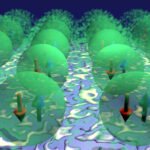Phase Transitions in Quantum Materials Examined by Researchers
Researchers from the University of Bonn and ETH Zurich have achieved a significant breakthrough in the field of quantum physics by directly proving the existence of phase transitions in fermionic materials. Phase transitions, where substances undergo a change in their properties, can occur either abruptly or gradually. For instance, water freezing into ice is an example of an abrupt phase transition, while the gradual transition from ferromagnetism to paramagnetism in iron is a continuous phase transition.
The researchers focused on continuous phase transitions and observed a phenomenon called “critical slowing down,” which refers to the gradual deceleration of a transition as the two phases approach each other energetically. Previously, this behavior had been typical for phase transitions involving bosons, particles responsible for interactions like magnetism.
The novelty of this research lies in its exploration of fermions, such as electrons, which are not typically associated with phase transitions due to their non-destructive nature. Fermions cannot be destroyed and, instead, can form a superposition state with mobile electrons in certain quantum materials, giving rise to quasiparticles. These quasiparticles, however, can be destroyed during a phase transition, leading to the observation of critical slowing down.
Although previous studies had indirectly detected the effects of critical slowing down in quasiparticles, the team from the University of Bonn and ETH Zurich developed a groundbreaking new method that directly identifies the collapse of quasiparticles and the associated critical slowing down during a phase transition. This advancement sheds light on the behavior of fermionic materials during phase transitions, deepening our understanding of the quantum world.
Moreover, the findings hold promise for advancements in quantum information technology. By gaining a better understanding of fermionic materials’ behavior during phase transitions, scientists may develop applications in quantum computing and other quantum technologies. The research was published in the prestigious journal Nature Physics. This pioneering work opens up new avenues for exploring the fascinating world of quantum physics and its practical applications.































